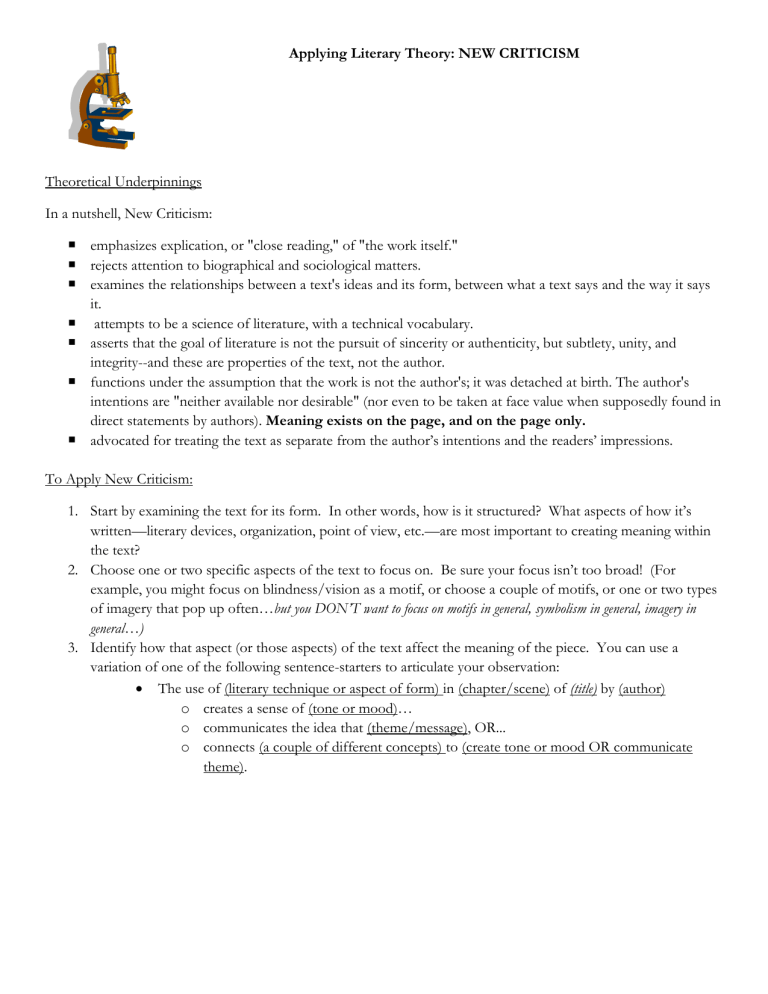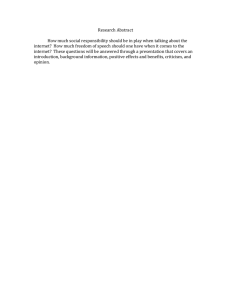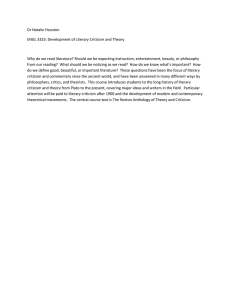
Applying Literary Theory: NEW CRITICISM Theoretical Underpinnings In a nutshell, New Criticism: emphasizes explication, or "close reading," of "the work itself." rejects attention to biographical and sociological matters. examines the relationships between a text's ideas and its form, between what a text says and the way it says it. attempts to be a science of literature, with a technical vocabulary. asserts that the goal of literature is not the pursuit of sincerity or authenticity, but subtlety, unity, and integrity--and these are properties of the text, not the author. functions under the assumption that the work is not the author's; it was detached at birth. The author's intentions are "neither available nor desirable" (nor even to be taken at face value when supposedly found in direct statements by authors). Meaning exists on the page, and on the page only. advocated for treating the text as separate from the author’s intentions and the readers’ impressions. To Apply New Criticism: 1. Start by examining the text for its form. In other words, how is it structured? What aspects of how it’s written—literary devices, organization, point of view, etc.—are most important to creating meaning within the text? 2. Choose one or two specific aspects of the text to focus on. Be sure your focus isn’t too broad! (For example, you might focus on blindness/vision as a motif, or choose a couple of motifs, or one or two types of imagery that pop up often…but you DON’T want to focus on motifs in general, symbolism in general, imagery in general…) 3. Identify how that aspect (or those aspects) of the text affect the meaning of the piece. You can use a variation of one of the following sentence-starters to articulate your observation: The use of (literary technique or aspect of form) in (chapter/scene) of (title) by (author) o creates a sense of (tone or mood)… o communicates the idea that (theme/message), OR... o connects (a couple of different concepts) to (create tone or mood OR communicate theme). When applying New Criticism… DO DON’T Include a clear, narrow thesis that makes Generalize without supporting with specifics. obvious what you’re going to focus on. New Criticism is about CLOSE READING, which means examining the text very carefully! Include, in the course of your analysis, LOTS of specific examples as evidence to support your Use “I think” or “In my opinion.” Remember, thesis. New Critics felt there were right answers to literature—individual interpretations are Explain the significance of your examples. irrelevant! What are they supposed to prove? How do they Try to cover too much. The more narrow your support your thesis? focus, the more in-depth your analysis will be. Speak with authority—but feel free to use hedge words when necessary (appears, perhaps, may, Talk about the author. He/she is dead, suggests) remember? WE DON’T CARE ABOUT THEM. Typical questions you might answer in a New Criticism analysis: How does the work use imagery to develop its own symbols? (i.e. making a certain road stand for death by constant association) What is the quality of the work's organic unity "...the working together of all the parts to make an inseparable whole..." (Tyson 121)? In other words, does how the work is put together reflect what it is? How are the various parts of the work interconnected? How do paradox, irony, ambiguity, and tension work in the text? How do these parts and their collective whole contribute to or not contribute to the aesthetic quality of the work? How does the author resolve apparent contradictions within the work? What does the form of the work say about its content? Is there a central or focal passage that can be said to sum up the entirety of the work? How do the rhythms and/or rhyme schemes of a poem contribute to the meaning or effect of the piece? Credit to http://public.wsu.edu/~delahoyd/new.crit.html and https://owl.english.purdue.edu/owl/resource/722/03/, from which much of this handout is adapted!


